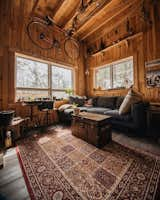A Filmmaker Builds a Rustic Off-Grid Cabin Deep in a Canadian Forest for $64K
This clifftop home on the east coast of Canada was entirely built by the owner—who had no experience building a house—and his friends.
Text by
Escaping the city and building a home in the wilderness from the ground up is a dream for many—but too often reality sets in, and the technicalities involved relegate this desire to the realm of fantasy. A Canadian filmmaker, however, recently brought his dream to life on a remote forested clifftop on the east coast of Canada.
Join Dwell+ to Continue
Subscribe to Dwell+ to get everything you already love about Dwell, plus exclusive home tours, video features, how-to guides, access to the Dwell archive, and more. You can cancel at any time.
Try Dwell+ for FREE
Already a Dwell+ subscriber? Sign In
Mandi Keighran
Design and travel writer based in London.
Published
Last Updated



